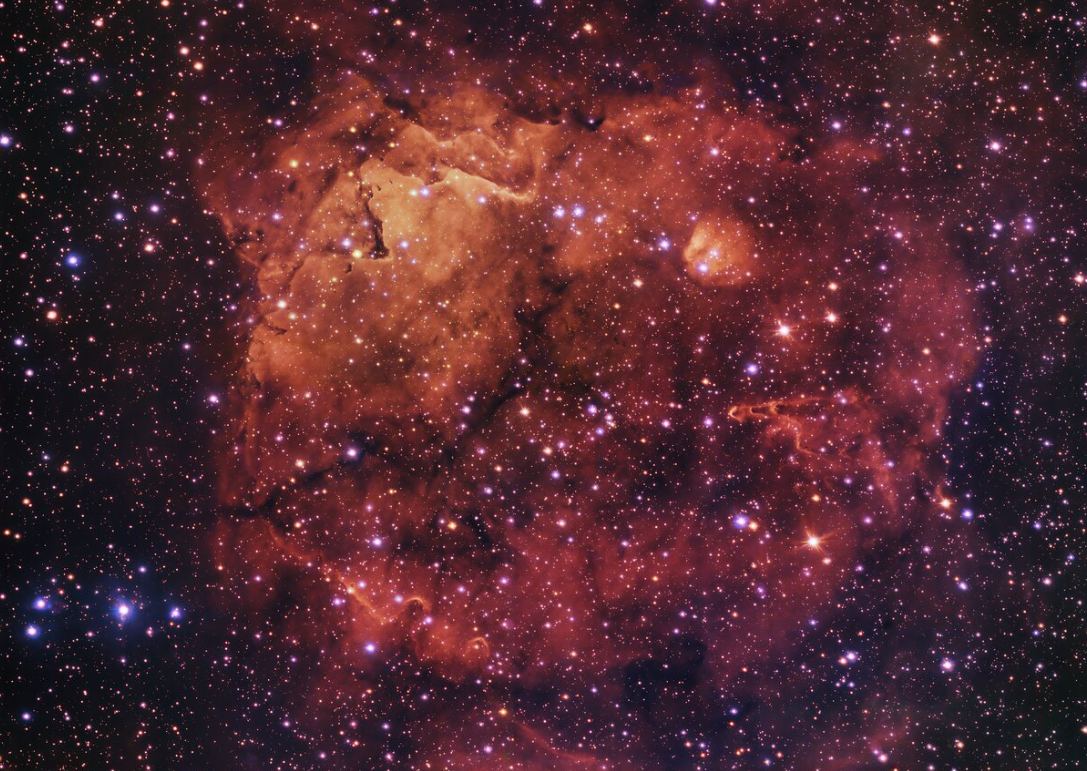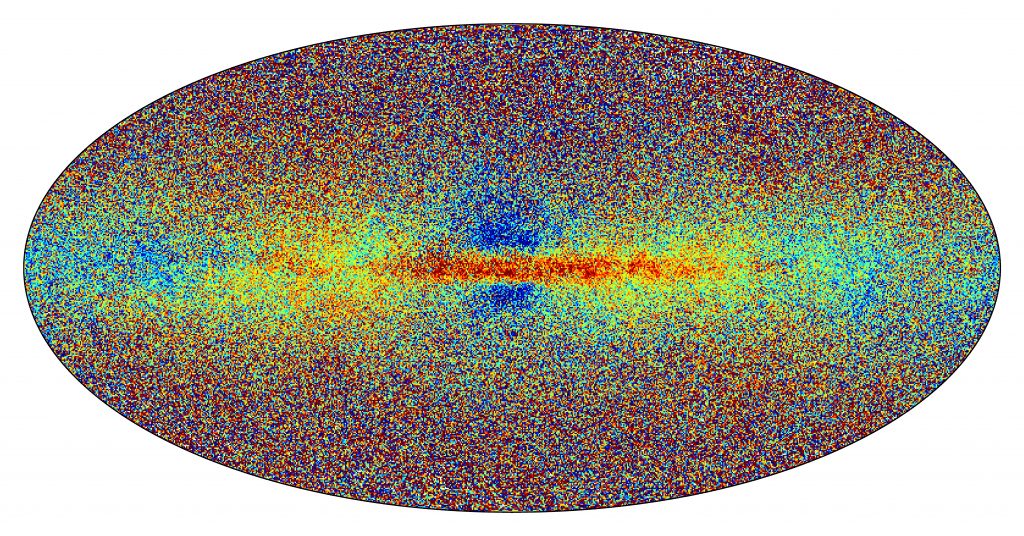A Feline in the Heavens: The Smiling Cat Nebula

A stellar nursery sounds like a placid place where 𝑏𝑎𝑏𝑦 stars go about their business undisturbed. But, of course, a stellar nursery is nothing like that. (Babies are noisy and cry a lot.) They’re dynamic places where powerful elemental forces rage mightily and bend the surroundings to their will. And this one, even though its name is the drowsy-sounding Smiling Cat Nebula, is no exception.
The Smiling Cat Nebula, aka Sh2-284, is about 15,000 light-years away in the constellation Monoceros (Unicorn.) Its bright central region is about 150 light-years across, and a group of young stars sits in the center. It’s a gigantic HII region, meaning it’s made of ionized hydrogen. And the powerful young stars in the center are doing the ionizing.
The group of young stars is called Dolidze 25, and it’s an open cluster. It contains O-type stars, hot, blue-white stars with temperatures as high as 30,000 K. Our Sun’s surface temperature is far lower, only about 5,700 K.
The stars pump out a lot of powerful UV energy that ionizes all that hydrogen. Without ionization, the nebula wouldn’t display these colours. But that’s not all the stars are doing.
They’re also blowing gas and dust away from the central region with their powerful stellar winds. But that’s an uneven process. Thicker clumps and knots of material can obstruct the winds, carving out what looks like gigantic pillars or fingers of gas and dust. There’s a prominent one on the image’s right side.

The pillars in this image are outlined in white dotted lines and are several light-years wide. They point towards the central cluster of stars. The structures form when winds (shown here as arrows) from the central star cluster meet denser pockets of material that are harder to erode away than the surrounding regions. The regions around the pillar are pushed away, while these magnificent structures are temporarily left behind. This image is part of the VST Photometric H-alpha Survey of the Southern Galactic Plane and Bulge, led by Janet Drew at the University of Hertfordshire in the UK. Image Credit: ESO/VPHAS+ team. Acknowledgement: CASU
There’s a lot going on in Dolidze 25, the open cluster in the Smiling Cat nebula’s heart. It’s a stellar nursery, which means some of the gas and dust is being swept up and compressed, triggering the 𝐛𝐢𝐫𝐭𝐡 of more stars. This is a chaotic process, as if there’s an unquellable storm raging for millions of years.
Active star-forming regions like this are extremely alluring to astronomers. They have many questions about the star-formation process, which often takes place hidden inside veils of gas and dust.
In a 2018 paper, researchers found that the stars in Dolidze 25 have much lower metallicity than our own Sun. In fact, they have the lowest known metallicity of any star-forming region in the entire Milky Way. Why is that?

This image from a 2018 paper shows stars in Dolidze 25 in blue. Image Credit: Negueruela et al. 2018.
Our galaxy has a metallicity gradient. Stars nearer the galactic center have higher metallicity than stars near the periphery. The higher metallicity is because they formed from material enriched by previous generations of stars. Since there are more stars being 𝐛𝐨𝐫𝐧 and dying nearer the galactic center, stars recently 𝐛𝐨𝐫𝐧 in that region form from material that’s been enriched by the stellar 𝐛𝐢𝐫𝐭𝐡/death cycle. But Sh2-284 and Dolidze 25 are located near the galactic anticenter. They’re relatively isolated out on the end of one of the Milky Way’s spiral arms.

This is a metallicity map derived from the 3rd data release from the ESA’s Gaia mission. Each dot is a star, and redder stars are richer in metals, that is, elements heavier than hydrogen and helium. Further from the center, stars are made of more primordial material. Image Credit: ESA/Gaia/DPAC; CC BY-SA 3.0 IGO, CC BY-SA 3.0 IGO
The same research showed that the stars are young, no older than about 3 million years. That’s mere infancy for stars.
As the stars in Dolidze 25 age, they will most likely leave each other’s company. As an open cluster, their gravitational bonds are pretty weak. Stars in open clusters usually have higher velocities than the cluster’s escape velocities, meaning they disperse over time. As time passes, the gas in Sh2-284 will also dissipate, driven away by the incessant wind generated by the young stars.

NASA’s WISE (Wide-field Infrared Survey Explorer) captured this infrared image of Sh2-284. It clearly shows how the stars in Dolidze-25 are carving out a bubble in the middle of the HII region. Image Credit: NASA/JPL-Caltech/UCLA
What does Sh2-284’s future look like? Planets will probably form around the stars in Dolidze-25. Thanks to NASA’s Kepler and TESS missions, we now know that nearly every star has planets.
Unfortunately for those of us rooting for other life in the Universe, the planets that form around these stars may not be rocky. The region’s low metallicity means that elements like oxygen, silicon, and iron—all considered to be metals in astronomy—are scarce. And those three elements make up the bulk of planet Earth, over 75% in fact.
With rocky planets unlikely to form, there will probably never be life. But if they do, and there is, then maybe one day, on one of the planets, life will follow the same long, intricate path to sentience that life on Earth followed. Maybe there’ll be astronomers who look our way in a few billion years to see the nebula created by our Sun when it reaches its end. Maybe they’ll see the likeness of some animal face in our nebula.
But that’s just fanciful daydreaming. The following is more likely.
In some millions of years, the region will look much different. The stars in Dolidze-25 will likely separate, the gas will continue to dissipate, and eventually, the region will stop 𝐛𝐢𝐫𝐭𝐡ing new stars. The Smiling Cat will be no more.
That’s okay. It doesn’t really look like a cat, anyway.





